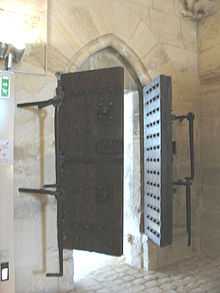Temple (Paris)
| The Paris Temple | |
|---|---|
| Paris, France | |
 | |
| A view of the Grosse Tour-circa 1795, Ecole Française 18th century. | |
| Type | Medieval fortress |
| Site information | |
| Condition | vanished |
| Site history | |
| Built | mid-13th century |
| Built by | Knights Templar |
| Events | French Revolution |

The Temple was a medieval fortress in Paris, located in what is now the 3rd arrondissement. It was built by the Knights Templar from the 12th century, as their European headquarters. In the 13th century it replaced earlier works of the Vieille Temple (Old Temple) in Le Marais. Parts of the fortress were later used as a prison.
The enclosure (called enclos du Temple) originally featured a number of buildings important to the running of the order, and included a church and a massive turreted keep known as Grosse Tour (great tower), and a smaller tower called Tour de César (Caesar's Tower). The fortress was destroyed in 1808 to avoid the pilgrimage of royalists (since this was the prison of Louis XVI for some time); today, the location of the towers is drawn on the floor in front of the town hall, rue Spuller. The heavy doors of the Grosse Tour still exist and are kept at Château de Vincennes whose great keep (attributed to Raymond du Temple) is speculated to have been inspired by the nearby Templar fortress.[1]
French Revolution
The Temple is notorious for having been the French royal family's jail at the time of the Revolution. The royals imprisoned at the Temple's tower were:
- King Louis XVI, who on 21 January 1793 was taken from there to be guillotined at the Place de la Révolution;
- Marie Antoinette, taken on 1 August 1793 from the Temple's tower to the Conciergerie, from where she eventually was also taken to the guillotine;
- Madame Élisabeth, who stayed for 21 months at the tower before being taken on 9 May 1794 to the Conciergerie and guillotined the following day;
- Louis XVII, who reportedly died of tuberculosis at the tower on 8 June 1795, at the age of ten;
- Princess Marie-Thérèse, who stayed at the tower for three years and four months before being sent into exile.
In 1808, the Temple having become a place of pilgrimage for royalists, Napoleon ordered its demolition, which took two years. There were remnants left that were demolished around 1860 under orders from Napoleon III. Today its location is a stop-over of the Paris Metro, the carreau du temple and the Palais de Justice (Courthouse) of the third arrondissement.

References in literature


Sources
Coordinates: 48°51′55″N 2°21′44″E / 48.86528°N 2.36222°E